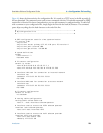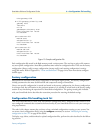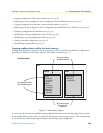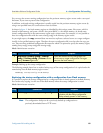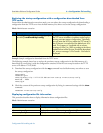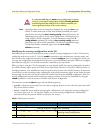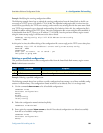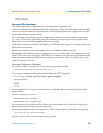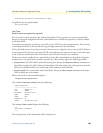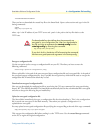
Configuration file handling task list 84
SmartWare Software Configuration Guide 6 • Configuration file handling
Note Application files can be very long when displayed (by using the show com-
mand). To make them easier to read, many default commands are not dis-
played when executing the
show running-config command. However, the
administrator may want to see the entire configuration, including these nor-
mally “hidden” default commands. To see all commands, execute the
cli
config defaults
command. By issuing a show running-config command
afterwards, you will see all the commands, a list which is significantly longer.
To hide these hidden commands again, issue the
no cli config
defaults
command.
Modifying the running configuration at the CLI
SmartWare accepts interactive modifications on the currently running configuration via the CLI. Interactive
configuring needs access to the CLI. Use the
enable command to enter administrator execution mode, and
then switch to the configuration mode by typing the command
configure. Once in configuration mode, you
can enter the configuration commands that are necessary to your SmartNode’s operation. When you configure
SmartWare by using the CLI, the shell executes the commands as you enter them.
When you log in using the CLI, all commands you enter directly modify the running configuration located in
the volatile memory region system: (or RAM) of your SmartNode. Because it is located in volatile memory, to
be made permanent, your modifications must be copied to the persistent (non-volatile) memory. In most cases
you will store it as the upcoming startup configuration in the persistent memory region nvram: under the name
startup-config. On the next start-up the system will initialize itself using the modified configuration. After the
startup configuration has been saved to persistent memory, you have to restart the SmartNode by using the
reload command to cause the system to initialize with the new configuration.
The execution command
reload accepts with the following options:
• graceful—reloads the system only if no voice calls are ongoing. If there are voice calls, the system waits until
they all are closed to reload.
• forced—reloads the system without prompting for confirmation or for saving the running-configuration
(no need to type yes or no). The question whether to save the running-configuration is automatically
answered with no, the question whether to reload or not with yes.
Mode: Administrator execution
It is recommended that you never save a configuration in startup-
config or a user-specific configuration with the cli config defaults
command because the additional list of default commands con-
sumes significant portions of the nvram: memory.
Step Command Purpose
1 node#configure Enters administrator configuration mode
2 Enter all necessary configuration commands.
3 node(cfg)#copy running-config startup-config Saves the running configuration file as the
upcoming startup configuration
4 node(cfg)#reload Restarts the system
IMPORTANT





